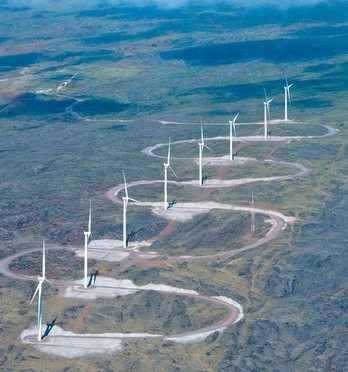The US State of Hawaii has been an innovator in renewable energy in recent years and has steadily been reducing its heavily reliance upon fossil fuels to supply its electricity needs, But still 70% of its electricity is supplied by oil.[1]
In 2014, a goal of 100% renewable energy by 2045 was set for the state.
Hawaii has four utilities covering six isolated grids. Hawaiian Electric Company (HECO) is responsible for the most populated island of Oahu, where Honolulu is located.
Maui Electric Company (MECO) is responsible for Maui, Molokai and Lanai. Hawaii Electric Light Company (HELCO) serves Hawaii (the big island), whilst Kauai is managed by Kauai Island Utility Co-operative (KIUC).
HECO, HELCO and MECO are all owned by Hawaiian Electric Industries (HEI) a public company, whilst KIUC is a community owned not-for-profit.
Geographically, and climactically there are significant differences between the islands and the opportunity to link power via undersea cables such as what connects Australia and Tasmania is difficult as whilst Bass Strait is around 50m deep, the Pacific Ocean is as much as 2 kilometres deep between the islands.
All islands have a great solar potential whilst wind tends to be better in the wind-surfing meca of Maui, Hawaii and some potential offshore expansion of the existing wind resource on the north shore of Oahu.
Run-of-river hydro exists in Kauai which has some of the highest rainfall areas in the world. Meanwhile, geothermal is unique to those island where there is active volcanic activity.
To illustrate this progress, we have examined some of these renewable energy projects.
In Kauai there are a significant number of renewable projects, including the 13MW Solarcity Solar farm with 13MW/52MWh of Tesla battery storage, which is designed primarily to shift solar production for around four hours from the middle of the day to the late afternoon and evening peak.
Figure 1 – Kapaa 13MW SolarCity Solar Farm with 13MW/52MWh Tesla energy storage
Another Kauai solar and storage facility is the Anahola 12MW solar farm, with 12MW/4.63MWh Saft Energy Storage System to maintain frequency and grid stability rather than shifting production to later in the day.
Figure 2 – Anahola 12MW Solar farm
On the western side of the Island, at the end of the picturesque Waimea canyon, the US Navy is examining the use of pumped hydro with PV generation at its Pacific Missile Facility, where defence systems such as THAAD were developed and new ones are trialled with the aim of shooting down incoming ICBM’s.
The US Navy wants energy independence and greater certainty by being able to generate and store its own energy whilst still be connected to the local network.
The island of Maui, which is famous for wind surfing, has three on-shore wind farms and there are proposals for additional wind farms. The Auwahi wind has a maximum rating of 21MW and is powered by eight Siemens SWT 3.0-101 turbines.
There is an 11MW battery from A123 systems which complements the wind farm with less than an hour of charge. This is used to manage the short-term changes in output from the wind farm to ensure the stability of Maui’s 200MW grid.
What is particularly compelling about Maui for wind is the high average wind speeds and the virtually unidirectional flow of the wind meaning that turbines can be placed closer together.
This is part 1 of a 3-part series on Hawaiian renewable energy, and in our next issue we examine what factors are driving this change. Warwick Forster is a director of Apogee Energy
[1]Richard Rocheleau, Hawaii Natural Energy Institute, IPS Connect 2018 exists in Kauai which has some of the highest rainfall areas in the world. Meanwhile geothermal is unique to Hawaii where there is active volcanic activity.
reneweconomy.com.au


